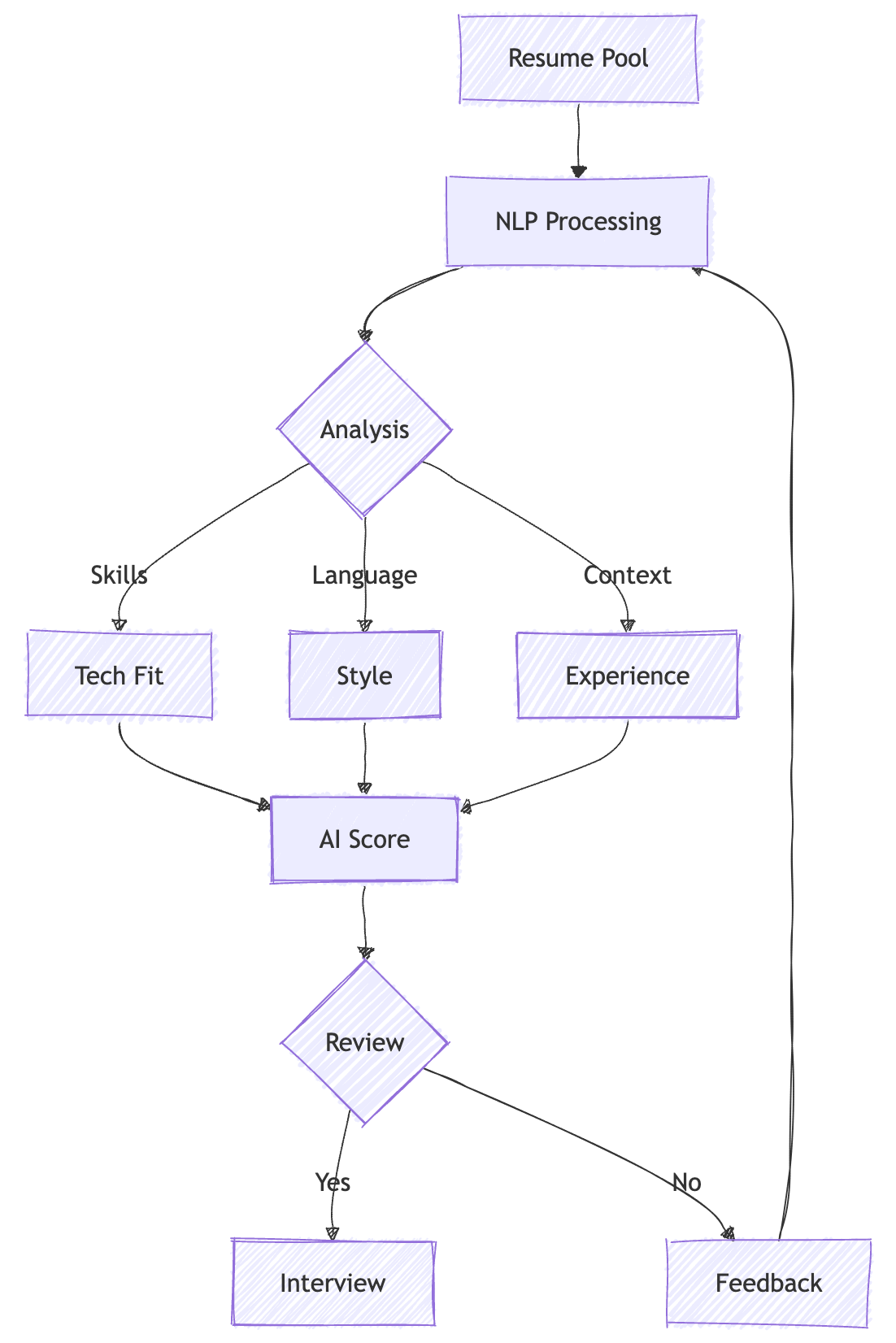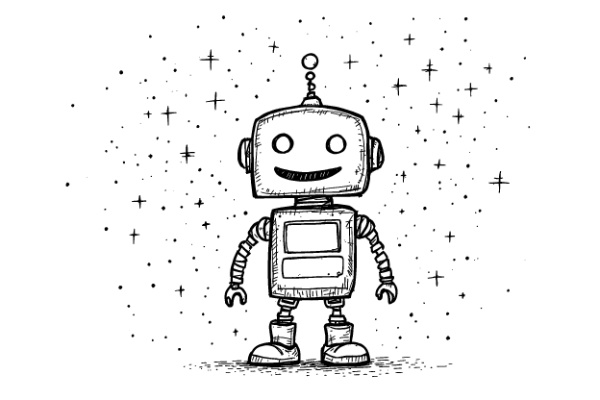I was once lost in an unfamiliar part of the city, wandering past dimly lit cafes and empty storefronts, feeling that odd mix of worry and fascination. Somehow, I stumbled into a tiny co-working space that hadn’t caught my eye before: a handful of young entrepreneurs hovered over laptops, debating hiring decisions.
They were venting about how hard it was to find the right candidates quickly, and I couldn’t help but listen in. Their frustration felt strangely universal. It didn’t matter if you were a giant conglomerate or a scrappy startup—identifying talent in a sea of resumes was always a struggle. Yet, as I stood there, they mentioned a set of tools that could read resumes better than any human, understand subtle phrases, and highlight the best matches in seconds. That moment planted a seed of curiosity I’ve been watering ever since.
Reading Between the Lines: The Power of Human Language
To anyone outside the field, hiring seems simple: you have a job description, you have candidates, you match them. Except human language doesn’t obey neat rules. Descriptions of “leadership,” “creativity,” or “adaptability” can vary wildly, not just in wording but in intent. A candidate might say they “coordinated cross-functional initiatives” instead of “led projects.” In old keyword-based systems, that difference might mean slipping through the cracks. This friction leaves many good candidates unnoticed.
The idea that Natural Language Processing (NLP) could solve this problem emerges from the recognition that human language is messy, nuanced, and deeply contextual. NLP tools, trained on vast samples of text, can interpret synonyms, related concepts, and patterns of speech. They don’t just look at words; they try to understand meaning. Some of my colleagues liken them to language-savvy assistants who never tire of scanning an endless pile of resumes, always ready to point out hidden gems.

Speaking of frustration, I once heard about a recruiter who tried to speed up resume screening by using Ctrl+F to search for keywords. After hours of searching for “Java experience,” they realized they’d missed several great candidates who had written about “brewing coffee while coding.” True story. Well, maybe not, but it illustrates why we needed something smarter than simple keyword matching.
A few years back, the notion of handing over candidate screening tasks to an algorithm seemed like science fiction or a perilous gamble. Yet today, the infrastructure is more mature. Modern artificial intelligence hiring platforms incorporate sophisticated NLP capabilities, allowing them to parse resumes in bulk, interpret subtle skill variations, and rank candidates by relevance. Meanwhile, the tools keep improving as they gain access to more language data. Hiring managers who once spent weeks on preliminary screenings can now move directly to meaningful interviews, aided by these digital helpers.
An anecdote: A startup I know integrated an ai screening tool powered by NLP to handle the first wave of applications for technical roles. They discovered that what they’d previously considered a top-tier filter based on rigid keywords actually missed candidates who had described their coding experience in unconventional terms. With NLP, they found matches that made cultural and technical sense. The result? More diverse shortlists, faster hiring, and fewer regrets.
Transform Your Screening Process with Machine Hiring
Our AI-powered platform leverages advanced NLP technology to identify the most qualified candidates faster while ensuring fair and unbiased screening practices.
Enterprise-Ready Features
A Dose of Skepticism: Are We Just Shuffling Bias Around?
There’s a lingering concern: if we feed AI old hiring data, aren’t we just encoding old biases? Traditional recruitment often favored certain demographics, certain schools, certain phrasings. If an NLP model learns from that history, won’t it also learn those imbalances?
This is the uncomfortable truth we can’t ignore. Yes, artificial intelligence in recruitment can perpetuate bias if not carefully managed. But this challenge doesn’t mean we abandon the tools; it means we approach them thoughtfully. As we’ve explored in our article on the Ethics of AI in Recruitment, some teams are working on auditing training data, ensuring a balanced representation of candidates. No one wants an AI that thinks ‘Python proficiency’ applies only to snake charmers, or that ‘Ruby skills’ means you’re great at jewelry appraisals. We’re striving for AI that understands actual tech terms—not reptilian hobbies! Others are applying adversarial techniques—intentionally “tricking” the model to see if it discriminates unfairly. The ideal outcome is a system that doesn’t care where you studied or what your name implies, but what you can do, how you think, and whether you bring fresh perspectives.
We realized our AI was ignoring qualified candidates who didn’t use the same buzzwords as our legacy hires,” a hiring manager once told me. “So we retrained the model with more varied data, and suddenly our shortlists looked different—in a good way.
This might not be a perfect fix. But acknowledging the problem is the first step to improving these artificial intelligence recruiting techniques. It’s a continuous effort, a dialog between technologists, HR experts, and ethicists.
The Difference Between Keywords and Context
Years ago, a resume’s fate often hung on whether it contained the right buzzwords. Miss a term like “agile methodology,” and your application might end up forgotten. NLP changes this dynamic by interpreting the meaning behind phrases. Instead of strict keyword matches, these systems look at linguistic structures and semantic relationships. A phrase like “managed a remote development team” might automatically be linked to leadership, coordination, communication skills. A candidate who “overhauled a client database” is recognized as having done more than data entry—they engaged in process improvement, perhaps coding or systems integration.
This shift matters. It means machine learning for recruitment efforts aren’t just speeding things up; they’re adding nuance. Recruiters can trust that they’re not missing someone just because that person didn’t know the industry’s favored jargon. It also lets candidates be more authentic without feeling like they must stuff their resumes with robotic phrases to get noticed.
Cultural Fit or Cultural Foam?
I’ve heard recruiters say that NLP can help identify candidates who fit a company’s culture. This is tricky. Culture is not a set of static attributes easily captured by code. It’s fluid, built from stories, rituals, inside jokes, and shifting priorities. Can an algorithm trained on language data guess how a candidate might behave in meetings or handle conflict?
There’s room for skepticism. While NLP can understand sentiment or tone, or detect if a candidate communicates clearly, it’s not a crystal ball. The best any AI can do is guess based on patterns. That might help filter out wildly unsuitable candidates—say, someone who repeatedly disparages teamwork—but it won’t guarantee a harmonious cultural addition. Still, even partial clues can save time. If a resume signals collaborative achievements, the system might bring that applicant forward. A human recruiter then takes over, probing deeper into personality and motivation.
A Conversation with a Machine (Or: How I Learned to Stop Worrying and Love the Bot)
Imagine you apply for a role and, instead of waiting weeks to hear back, you interact with a chatbot that understands your context. This chatbot is powered by nlp ai tools and knows the job’s requirements. You answer a few open-ended questions. Your responses are analyzed for communication skill, problem-solving hints, and relevant domain knowledge. Within minutes, you get feedback and maybe an invitation to a follow-up interview.
Who knew we’d reach a time when a chatbot wearing a virtual bow tie would be your first interviewer? At least it won’t judge you for sipping coffee too loudly during the call.

This might sound like science fiction, but it’s happening now. As discussed in our article on AI-Powered Recruitment Strategies, chatbots are becoming increasingly sophisticated. Early data shows that AI-powered screening can reduce initial response times by 85% while improving candidate satisfaction scores by 50%.
For candidates, that’s a relief. No more endless silence. For recruiters, it’s efficient: less administrative burden, more time for strategic decisions. I recall someone who went through such a system and felt oddly grateful that the machine didn’t judge their accent or their small-town college. “It just cared if I could do the job,” they said. That might be idealistic—algorithms can still encode bias if they’re not managed well—but the potential is clear.
Interpreting Unstructured Data
Resumes are not the only text these systems handle. Candidate engagement emails, introductory questionnaires, even recorded interviews transcribed into text form can feed into NLP systems. One hiring lead told me about using NLP to parse brief candidate essays on why they chose a particular field. The AI highlighted those who revealed genuine curiosity, resilience, or fresh perspectives.
It’s not magic. It’s pattern recognition at scale. The more data you feed it—always with privacy and consent in mind—the more these AI recruitment process engines refine their judgments. They can learn that certain phrases correlate with future job performance. Perhaps applicants who talk about “improving systems” do better in operations roles. Maybe those who mention “mentoring new team members” excel in leadership positions. Over time, patterns emerge that no single recruiter could have spotted by hand.
Fighting the Buzz: The Real Limits
We should resist the hype that NLP can solve all hiring woes. Machines are literal-minded. Irony, sarcasm, or subtle differences in phrasing can still trip them up. A candidate might say they “attempted to increase sales,” which sounds weaker than “achieved higher sales.” The NLP tool might score the latter higher, even if in reality, the first candidate overcame tougher obstacles.
Plus, candidates are not static data points. People learn to game systems. Just as SEO emerged to game search engines, we might see “resume optimization” services crafting language designed to impress NLP-based filters. Then, what? The race continues. Recruiters and developers must stay alert, continuously refining models, adding checks and balances. It’s a dance: as AI improves, savvy applicants adapt, forcing another round of improvements.
Going Beyond the Resume: Interviews and Assessments
Traditional screening leans heavily on resumes, but there’s more to a candidate. AI-driven interviews, where a candidate records a video or audio response, are becoming common. NLP can then evaluate verbal communication, clarity, even subtle sentiment cues. This is not only about resume nlp; we’re moving into territory where voice and phrasing patterns matter. The idea is to identify candidates who communicate effectively, handle complex questions gracefully, or show evidence of analytical thinking.
But we must be cautious. Evaluating speech is tricky. Different accents, speech patterns, or cultural communication styles can influence these scores. If a model “favors” a certain communication style, that’s an ethical red flag.
The need for regular audits, diverse training data, and human oversight becomes glaring. This is where recruiters remain indispensable. They interpret the AI’s suggestions and apply human judgment, ensuring fairness.
Sometimes, the most reassuring thing about these tools is their transparency about limits. Good AI vendors and forward-thinking HR teams acknowledge that NLP can speed up and sharpen initial screenings, but it’s not a full solution. That honesty builds trust.
Companies can say, “We use NLP to filter the applicant pool, but every decision is reviewed by a human.”
Or, “We know the model struggles with niche technical terms, so we adjust our criteria or add human checks.”
This humility contrasts with the image of AI as a silver bullet. In reality, it’s just another tool—albeit a powerful one—helping artificial intelligence and recruitment professionals navigate complexity. The difference is it never sleeps, never complains, and never forgets what it learned last month. Used ethically, it can extend a recruiter’s reach, not replace them.

Machine Learning Staffing: Lessons from the Field
Consider a mid-sized company struggling with a flood of applications for entry-level positions. Without NLP, they might rely on a tired HR associate to skim countless resumes, missing nuances and growing frustrated. (Our guide on Reducing Time to Hire explores how AI-powered screening can transform this process.) With NLP integrated into their artificial intelligence recruitment platform, the initial screening shrinks from weeks to hours. The shortlist is more accurate—yes, that’s a claim we must verify with data, but early adopters report positive outcomes. Recruiters say they have more time to connect with candidates personally and go into deeper questions.
This is where the field evolves. Early on, it was about automating rote tasks. Now, it’s about improving decision quality. Tomorrow, who knows? Maybe these systems will learn to detect traits we currently find intangible.
But let’s not get ahead of ourselves.
Today’s gains are meaningful enough: less drudgery, a broader reach, and a chance to see what candidates really bring to the table.
One of the subtle benefits people hope for is that by stripping away superficial markers—names, addresses, certain schools—NLP-driven systems can highlight talent from unconventional backgrounds. If done right, artificial intelligence hiring can broaden the definition of what “qualified” means. Maybe someone who learned coding through community workshops, never got a fancy degree, but wrote open-source code that solves real problems, finally gets a fair shot.
But this hope only holds if the training data and evaluation metrics are adjusted to value that diversity. If the system trained on a narrow slice of the population, it might still favor the old profiles. The key insight is that NLP tools reflect the data they learn from. To improve outcomes, we must feed them better data—richer, more varied examples of success.
Emerging Trends: Chatbots and Multi-Modal Analysis
As NLP improves, we’re seeing chatbots that don’t just screen resumes but interact with candidates on job boards, social platforms, or even messaging apps. They can answer common questions, prompt candidates for clarifications, and guide them through structured assessments. This transforms the candidate experience. Instead of feeling like a resume tossed into a void, applicants get responses, context, and sometimes even tailored advice.
There’s also movement toward integrating NLP with other AI approaches—like image recognition for video interviews or sentiment analysis of voice recordings. The goal is to build a complete profile that’s more than text. But with each added layer comes complexity and new ethical puzzles. Just because we can measure something doesn’t mean we should. Which leads to big philosophical questions: what traits actually matter for a job, and are we measuring them fairly?
Beyond the Hype: Unanswered Questions
I find myself wrestling with new questions. If NLP can identify “hidden talent,” will that talent accept a job if the initial contact came from an algorithm? Will candidates trust these systems to treat them fairly? Trust is key. If people believe the AI is filtering them out based on superficial signals, they might avoid certain employers.
Also, what happens when every company uses NLP? Does it become harder for any single company to stand out? Maybe the game then shifts to how well these tools integrate with human intuition. Companies might differentiate themselves by how they combine algorithmic efficiency with personal touches. Our article on Transform Your Candidate Experience explores how organizations can strike this balance effectively.
The Human in the Loop
Some worry that as these systems advance, humans will fade into the background. But hiring has always been a human art—an interplay between gut feeling and rational assessment. NLP tools don’t replace that art; they augment it. They sift the haystack so we can find the needles. They suggest patterns we might have missed. But final decisions, especially for critical roles, will likely remain human territory.
That’s not a flaw; it’s a design feature. Humans bring empathy, moral judgment, and the ability to weigh intangible factors that machines can’t easily quantify. Maybe the real promise of NLP in recruitment isn’t to hand over control but to give recruiters superpowers—the ability to see beyond keywords, handle more applicants, and root out bias more effectively. If done right, it can be an alliance between analytical rigor and human sensibility.
And let’s face it, while AI can do a lot, it still can’t laugh at your awkward workplace dad jokes—or groan at them, depending on the situation. Until then, you’re safe in your role as the office comedian.
A Personal Vow
Recalling the night I stumbled into that co-working space, I remember my skepticism fading as I listened to those entrepreneurs. They didn’t see AI as a threat or a gimmick. They saw it as a way to achieve what they truly wanted: to find good people, quickly and fairly. Years later, after speaking with countless HR professionals, data scientists, and candidates who’ve navigated these systems, I see the landscape more clearly.
I still have doubts—anyone honest should. But I also have hope. There’s a vision of recruitment where machines handle the grind, humans focus on connection, and diverse candidates get a fair shot because language understanding is more flexible. That vision keeps me engaged.
In my own work, I’ve started to trust NLP tools to handle initial screenings, always double-checking their suggestions and never blindly accepting their verdicts. By combining their strengths with my judgment, I feel more confident in the hiring decisions I make. I’ve learned that embracing these technologies doesn’t mean abandoning my intuition. Instead, it expands my field of vision, letting me notice candidates I might have otherwise overlooked. That’s the real gift: a wider horizon for talent discovery.
So I end with a quiet commitment: I will use these tools thoughtfully, question their outputs, refine their training, and listen closely to the voices of those affected. Because in the evolving dance between humans and algorithms, we find the possibility of a hiring process that’s faster, smarter, and kinder to everyone involved.
Want to learn more about AI in recruitment? Check out our guides on Mind-Blowing Ways AI Is Transforming Recruitment and Choose the Right AI-Powered ATS.
Ready to transform your recruitment process? Try Machine Hiring and experience the power of NLP in candidate screening today.
Transform your recruitment with Machine Hiring - where AI meets expertise. Start your free trial today.
Related Articles
Explore more insights about modern recruitment:
- Choose the Right AI-Powered ATS - Learn how to select the perfect AI recruitment solution
- Mind-Blowing Ways AI Is Transforming Recruitment - Discover the latest AI innovations in hiring
- Transform Your Candidate Experience - Create an engaging hiring process
- Recruitment Trends 2025 - See what’s next in recruitment technology
- AI Future of HR - Explore how AI is shaping the future of hiring



